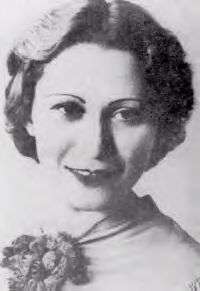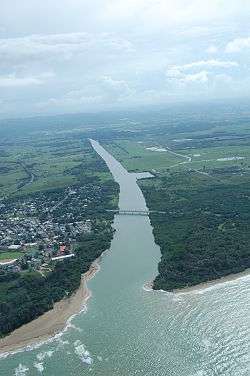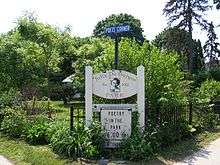Julia de Burgos
Julia de Burgos García (February 17, 1914 – July 6, 1953) was a Puerto Rican poet.[1][2][3][4] As an advocate of Puerto Rican independence, she served as Secretary General of the Daughters of Freedom, the women's branch of the Puerto Rican Nationalist Party.[5] She was also a civil rights activist for women and African/Afro-Caribbean writers.
Julia de Burgos | |
|---|---|
 Julia de Burgos | |
| Born | Julia Constancia Burgos García February 17, 1914 Carolina, Puerto Rico |
| Died | July 6, 1953 (aged 39) Manhattan, New York, United States |
| Occupation | Poet, activist |
| Nationality | Puerto Rican |
| Period | 20th century |
| Genre | Lyric poetry, lament |
| Literary movement | Puerto Rican Independence |
| Notable works | El Rio Grande de Loiza |
| Part of a series on the |
| Puerto Rican Nationalist Party |
|---|
 Flag of the Puerto Rican Nationalist Party |
|
Events and revolts |
|
Nationalist leaders
|
|
Notable nationalists
|
Early years
Julia de Burgos (birth name: Julia Constanza Burgos García) was born to Francisco Burgos Hans (a farmer) and Paula García de Burgos.[6] Her father was a member of the Puerto Rico National Guard and had a farm near the town of Carolina, Puerto Rico, where she was born. The family later moved to the barrio of Santa Cruz of the same city. She was the oldest of thirteen children. Six of her younger siblings died of malnutrition. Her first work was Río Grande de Loíza.[5]
After she graduated from Muñoz Rivera Primary School in 1928, her family moved to Rio Piedras where she was awarded a scholarship to attend University High School.[5] In 1931, she enrolled in University of Puerto Rico, Rio Piedras Campus to become a teacher.
In 1933, de Burgos graduated at the age of 19 from the University of Puerto Rico with a degree in teaching. She became a teacher and taught at Feijoo Elementary School in Barrio Cedro Arriba of Naranjito, Puerto Rico. She also worked as writer for a children's program on public radio, but was reportedly fired for her political beliefs.[5] Among her early influences were Luis Lloréns Torres, Mercedes Negrón Muñoz a.k.a. "Clara Lair", Rafael Alberti and Pablo Neruda. According to de Burgos, "My childhood was all a poem in the river, and a river in the poem of my first dreams."[5]
Nationalist
In 1934, de Burgos married Ruben Rodriguez Beauchamp and ended her teaching career. In 1936, she became a member of the Puerto Rican Nationalist Party (Partido Nacionalista de Puerto Rico) and was elected to the position of Secretary General of the Daughters of Freedom, the women's branch of the Nationalist Party.[5] The Puerto Rican Nationalist Party was the independence party headed by Pedro Albizu Campos, a Puerto Rican Nationalist. She divorced her husband in 1937.
Literature

| External audio | |
|---|---|
By the early 1930s, de Burgos was already a published writer in journals and newspapers. She published three books which contained a collection of her poems. For her first two books, she traveled around the island promoting herself by giving book readings. Her third book was published posthumously in 1954. De Burgos' lyrical poems are a combination of the intimate, the land and the social struggle of the oppressed. Many critics assert that her poetry anticipated the work of feminist writers and poets as well as that of other Hispanic authors.[7] In one of her poems, she writes: "I am life, strength, woman."[8] De Burgos received awards and recognition for her work and was celebrated by poets including Pablo Neruda, whom she met in Cuba, and stated that her calling was to be one of the greatest poet of the Americas.[6]
Among de Burgos' works are:
- El Rio Grande de Loiza[9]
- Poema para Mi Muerte (My Death Poem),
- Yo Misma Fui Mi Ruta (I Was My Own Path),
- Alba de Mi Silencio (Dawn of My Silence),
- Alta Mar y Gaviota
Later years
Later in life, de Burgos became romantically involved with Dr. Juan Isidro Jimenes Grullón, a Dominican physician. According to Grullón, many of her poems during that time were inspired by the love that she felt for him.[5] In 1939, de Burgos and Jimenes Grullón traveled first to Cuba where she attended briefly the University of Havana [6] and then later to New York City where she worked as a journalist for Pueblos Hispanos, a progressive newspaper.
Shortly after their arrival in Cuba, de Burgos' relationship with Jimenes Grullón began to show tension.[6] After trying to save her relationship, she instead left and returned once again to New York, however this time alone, where she took menial jobs to support herself. In 1943, she married Armando Marín, a musician from Vieques. In 1947, the marriage also ended in divorce, lapsing de Burgos into further depression and alcoholism.
By: Julia de Burgos
It has to be from here,
right this instance,
my cry into the world.
My cry that is no more mine,
but hers and his forever,
the comrades of my silence,
the phantoms of my grave.
In February 1953, she wrote one of her last poems, "Farewell in Welfare Island."[6][11] It was written during her last hospitalization and is believed by her peers to be one of the only poems she wrote in English. In the poem she foreshadows her death and reveals an ever darker concept of life.[12]
Death
On June 28, 1953, de Burgos left the home of a relative in Brooklyn, where she had been residing. She disappeared without leaving a clue as to where she went.[12]
It was later discovered that on July 6, 1953, she collapsed on a sidewalk in the Spanish Harlem section of Manhattan, and later died of pneumonia at a hospital in Harlem at the age of 39. Since no one claimed her body and she had no identification on her, the city gave her a pauper's burial on Hart Island, the city's only potter's field.[12]
Eventually, some of her friends and relatives were able to trace her, find her grave, and claim her body. A committee was organized in Puerto Rico, presided over by Dr. Margot Arce de Vázquez, to have her remains transferred to the island. De Burgos's remains arrived on September 6, 1953 and funeral services for her were held at the Puerto Rican Atheneum. She was given a hero's burial at the Municipal Cemetery of Carolina. A monument was later built at her burial site by the City of Carolina.[13]
Honors
In 1986, the Spanish Department of the University of Puerto Rico posthumously honored de Burgos by granting her a doctorate in Human Arts and Letters.[14]
Cities that have honored de Burgos include:
- Carolina, Puerto Rico
- Escuela Julia de Burgos[15]
- Cleveland, Ohio
- Julia De Burgos Cultural Arts Center[16]
- New York City, New York
- Philadelphia, Pennsylvania
- Chicago, Illinois
- Julia de Burgos Park
- San Juan, Puerto Rico
- Casa Protegida Julia de Burgos (domestic violence shelter)[21]
- Willimantic, Connecticut
- Julia de Burgos Pocket Park

The Puerto Rican sculptor Tomás Batista sculpted a bust of de Burgos in the Julia de Burgos Park in Carolina. Isabel Cuchí Coll published a book about de Burgos titled Dos Poetisas de América: Clara Lair y Julia de Burgos. Puerto Rican poet Giannina Braschi, who was born the year of de Burgos' death, pays homage to her poetry and legend in the Spanglish novel Yo-Yo Boing![22]
At Yale University, the Latino Cultural Center is named in her honor, La Casa Cultural Julia de Burgos.
A documentary about the life of de Burgos was made in 2002 titled "Julia, Toda en mi ... " (Julia, All in me ... ) directed and produced by Ivonne Belén. Another biopic about her life, "Vida y poesía de Julia de Burgos," was filmed and released in Puerto Rico in 1978.
In New York City, the Julia de Burgos Cultural Center, on 106th Street and Lexington Avenue, is named after her.[17]
On September 14, 2010, in a ceremony held in San Juan, the United States Postal Service honored de Burgos' life and literary work with the issuance of a first class postage stamp, the 26th release in the postal system's Literary Arts series. The stamp's portrait was created by Toronto-based artist Jody Hewgill.[18][23]
In 2011, de Burgos was inducted into the New York Writers Hall of Fame.
There is a plaque, located at the monument to the Jayuya Uprising participants in Mayagüez, Puerto Rico, honoring the women of the Puerto Rican Nationalist Party. De Burgos' name is on the sixth line of the third plate.
On May 29, 2014, The Legislative Assembly of Puerto Rico honored 12 illustrious women with plaques in the "La Plaza en Honor a la Mujer Puertorriqueña" (Plaza in Honor of Puerto Rican Women) in San Juan. According to the plaques each of the 12 women, who by virtue of their merits and legacies, stand out in the history of Puerto Rico. De Burgos was among the 12 who were honored.[24]
In September 2017, artist-activist Molly Crabapple (herself of Puerto Rican descent) disbursed the profits of the sales of her portrait of de Burgos to the Puerto Rico Hurricane Maria Recovery Fund. The Giclee 17″ x 22″ print is captioned with one of the poet's most famous lines: "En todo me lo juego a ser lo que soy yo/I gamble everything to be what I am."[25]
In 2018, the New York Times published a belated obituary for her.[26]
In music
The third movement of Leonard Bernstein's Songfest: A Cycle of American Poems for Six Singers and Orchestra is a setting of de Burgos' poem "A Julia de Burgos". Jack Gottlieb wrote, "In angry words (sung in Spanish) she expresses her defiance of the dual role she plays as a conventional woman and as a liberated woman-poet. (Her poem antedates by two decades the women's liberation movement.) The music is sharply rhythmic, and might well be underscoring for a bullfight."
Publications
- Song of the Simple Truth: The Complete Poems of Julia de Burgos (dual-language edition: Spanish, English), trans. Jack Agueros. Curbstone Books, 1997; ISBN 978-1-88068-424-5
- Yo misma fui mi ruta, Ediciones Huracán, 1986; ISBN 0-940238-30-6
- Amor y soledad, Ediciones Torremozas, 1994; ISBN 84-7839-136-3
- El Mar Y Tu, Ediciones Huracan, 1981; ISBN 0-940238-46-2
- Cancion De La Verdad Sencilla (Vortice Ser), Ediciones Huracan, 1982; ISBN 0-940238-66-7
- Poema en Veinte Surcos, Ediciones Huracan, 1983; ISBN 0-940238-23-3
- Poema Río Grande de Loíza[27]
- Poemas exactos de mí misma[27]
- Dame tu hora perdída[27]
- Ay, ay, ay de la grifa negra[27]
Biographical/Documentary films
- "Julia...Todo En Mi" on the Internet Movie Database
- "Vida y poesía de Julia de Burgos on the Internet Movie Database
See also
- List of Latin American writers
- List of Puerto Rican writers
- List of Puerto Ricans
- Puerto Rican literature
- Multi-Ethnic Literature of the United States
- Puerto Rican Nationalist Party
- History of women in Puerto Rico
Female members of the Puerto Rican Nationalist Party
References
- "Julia de Burgos Books & Crafts". Archived from the original on July 15, 2008. Retrieved July 15, 2008.
- "Julia De Burgos". IMDb.
- Bio. Archived December 3, 2013, at the Wayback Machine
- "Latin America Today". Archived from the original on October 2, 2013. Retrieved July 15, 2008.
- Song of the Simple Truth: The Complete Poems of Julia de Burgos. Curbstone Books; 1st edition (January 1997). ISBN 1-880684-24-1.
- Burgos, Julia de (2015). Cartas a Consuelo. San Juan: Folium. ISBN 978-0-9826317-8-2.
- Hispanic Heritage
- "Julia de Burgos, Celebrated Poet, Honored on U.S. Stamp".
- "Río Grande de Loíza". elboricua.com.
- "Julia de Burgos (1914-1953)". www.literatura.us.
- Julia de Burgos. Gale
- Perez, Vanessa; York, ContributorProfessor at the City University of New (March 4, 2013). "Celebrating 99 years of Julia de Burgos". HuffPost.
- "Monumento a Julia de Burgos en Carolina, Puerto Rico". Archived from the original on August 9, 2017. Retrieved November 3, 2017.
- Pérez Rosario, Vanessa (2014). Becoming Julia de Burgos: The Making of a Puerto Rican Icon. Urbana: University of Illinois Press. p. 152. ISBN 0252038967.
- Escuela Julia de Burgos Archived July 18, 2011, at the Wayback Machine from www.de.gobierno.pr
- Center, Julia De Burgos Cultural Arts. "Julia De Burgos Cultural Arts Center". Julia De Burgos Cultural Arts Center.
- Julia de Burgos Cultural Center from www.juliadeburgos.org
- Poet Julia de Burgos gets stamp of approval from the New York Daily News. September 15, 2010.
- Julia de Burgos Elementary School Archived September 28, 2011, at the Wayback Machine from www.phila.k12.pa.us
- Deburgos Bilingual Magnet Middle School from www.greatschools.org
- Casa Protegida Julia de Burgos from www.casajulia.org
- Loustau, Laura R. (2002). "Poetas en Nueva York: Julia de Burgos y Giannina Braschi," Cuerpos errantes: Literatura latina y latinoamericana en Estados Unidos. Argentina. pp. 133–144. ISBN 9508451181.
- Postal News: 2010 Stamp Program Unveiled Archived June 6, 2011, at the Wayback Machine from www.usps.com. December 30, 2010.
- "La mujer en nuestra historia".
- Crabapple, Molly. "PORTRAIT OF JULIA DE BURGOS". MollyCrabapple. Retrieved September 30, 2017.
- "Overlooked No More: Julia de Burgos, a Poet Who Helped Shape Puerto Rico's Identity - The New York Times". Nytimes.com. Retrieved May 4, 2018.
- "Julia de Burgos". www.elboricua.com.
External links
- The Complete Chronology / Cronología Completa de su vida y obra Review
- Julia de Burgos on IMDb
- Julia de Burgos stamp (U.S. Postal Service site)
- Centro Journal. Special Issue on Julia de Burgos
- Julia de Burgos on BlackPast
- J'S THEATER: Poem: Julia de Burgos's "To Julia de Burgos"